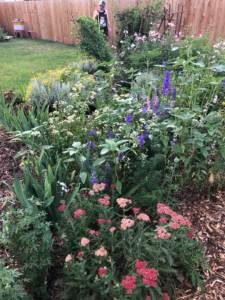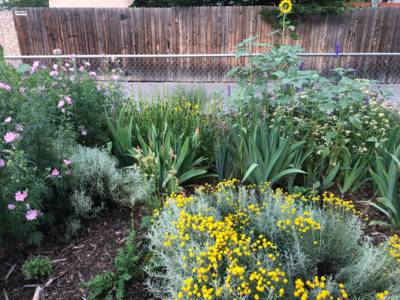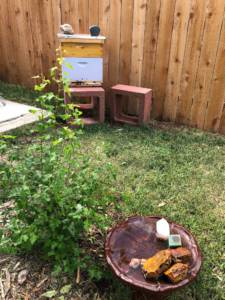By Paige McGlaughlin
Late summer is the perfect time to start greening your concrete. Save money on water bills, alleviate urban heat islands, and provide a haven for pollinators by starting a garden. Any patch of concrete or turf, no matter how large or small, can be transformed into a beautiful green space to enhance your surroundings.
Why are gardens important in an urban or suburban setting? Water-wise, pesticide-free gardens can replace heat-trapping concrete or thirsty grass turf and provide an oasis for butterflies, birds, bees and other pollinators and insects. Gardening has been shown to alleviate stress and gardens can provide herbs, and even vegetables, for cooking and medicinal purposes.
Here are some images of my home pollinator garden created by removing a large slab of concrete and replacing with topsoil and compost. Bee-friendly, Xeric (low water) plants were added from a variety of sources, and finally a layer of mulch to assist in preventing evaporation and weeds.


Left: Pollinator garden grown from a “Garden in a Box”, as well as local greenhouse purchases, attracts native bees and butterflies. Right: Sunflowers can be easily grown from pesticide-free seeds.
8 Steps to Green your Concrete
- Remove concrete. To remove concrete, there are options depending on the size of the slab. If it is small, break it up with some old-fashioned hard work using a sledgehammer and disposing of it properly. For larger pieces, a general contractor can assist with removal and disposal. After removing concrete, the city of Denver will re-measure the impervious area of a property via satellite, thereby reducing the bi-yearly wastewater bill for that property in perpetuity. This can be done over the phone with Denver Wastewater Management after the concrete is removed. Removing concrete increases the ability of the ground to absorb water, reducing runoff and erosion.
- Remove turf. To remove turf, there are several methods. Digging or cutting out sod is one option, while another is to till and then remove the chunks of grass from the soil. Both of these require significant energy or mechanical equipment. An easier, but more time-consuming method is to cover the unwanted turf with large pieces of cardboard until it no longer receives enough sun to complete photosynthesis. When choosing an option to remove turf, consider how much energy to expend and how much soil to preserve. Replacing turf with Xeric plants will reduce the amount of water necessary to maintain green areas, while providing beauty and a harbor for insects and birds that turf does not. Do not use grass-killers to remove turf, as these will destroy any beneficial organisms in the soil.
- Prepare the soil for plants: If large areas of concrete were removed, they will likely need to be replaced with topsoil. Many companies will deliver topsoil, and they often have different choices of soil to fit different needs. Topsoil can also be purchased in smaller quantities at a local greenhouse or hardware store. Once topsoil is sufficient, add organic amendments to the soil to assist with drainage and root development. Organic amendments can include: peat moss, grass clippings, old leaves, compost, chopped 350 coloradostraw, or aged manure. Add 2” of organic amendments, and turn or till the organic materials into the soil 6”-8” deep.
- Plant water-wise, pollinator-friendly plants! This is the fun part! Plants can be sourced from a variety of places, as well as grown from seed. Fall-planting is perfect for many perennials, as well as for seeds that need to go through a cold stratification process. For an easy solution to water-wise planting, the Center for Resource Conservation provides Xeric plants in a convenient “Garden in a Box” that can be purchased through their website at: https://resourcecentral.org/gardens/. Fall gardens go on sale soon, with pick-up available in September. Residents of specific cities can also receive a $25.00 credit when purchasing a Garden in a Box (see information on their website regarding rebates.) Plants can also be sourced from local greenhouses and plant sales. Many beautiful plants can be grown from seeds purchased at local grocery stores. Make sure that plants/seeds are not treated with neonicotinoid pesticides, as these have been shown partially responsible for collapse in honey bee colonies. If purchasing plants at Home Depot, look for labels that indicate plants are free of neonicotinoids, as one of their suppliers, Bonny Plants, does not use neonicotinoids, and will indicate this on the label. Opt to purchase organic seed stock, as these are not treated with pesticides. Consider planting native and pollinator attracting varieties when choosing plants. Give plants plenty of space when planting.
- Mulch the new garden. Mulch should be applied on top of the soil after planting to help the soil retain water, stay cool, and to discourage the growth of invasive weeds. Mulch can also help maintain the attractiveness of a garden. Some materials that can be applied as mulch include: straw, leaves, grass clippings, shredded bark or wood chips. Mulch can be purchased in bags at a local greenhouse or hardware store, or if you have a large area that needs mulch it can be delivered for free to your property by signing up for a “Chipdrop” service at: https://getchipdrop.com/. A large empty area that is accessible for a trailer is required to receive this service, as the loads are very large. Mulching a garden is a MUST in the dry Colorado climate.
- Water wisely. Water the garden according to city regulations in the summer. Xeric plants will need more water the first year after planting, but will require less as the plants grow in years two and three. Water early in the morning or in the evening to help the soil maintain water. Consider breaking up the soil with a pronged garden tool before watering to help moisture penetrate the soil. Keep adding mulch as needed to prevent water loss to evaporation and to keep soil cool. Let soil dry in between watering, and check the soil conditions to determine if watering is needed beforehand.
- Get gardening tips and maintain the garden. There are many resources to help Colorado gardeners. Colorado State University Extension offers many great articles on the subject at: https://extension.colostate.edu/topic-areas/yard-garden/. Visit this site for more information regarding soil amendments, mulching, Xeriscaping and many other topics. Maintain the garden by pulling weeds instead of adding pesticides which kill beneficial insects and pollinators, and reduce the living soil biome to a sterile condition. Add a beautiful water container to the garden to attract butterflies and bees that also need a drink.
- Enjoy looking at your new garden and watching it grow. Keep adding plants! Watch for butterflies and native bee species that will be attracted to the microcosm you have created. Who knows, in the end you may even end up with a backyard bee-hive like mine!

